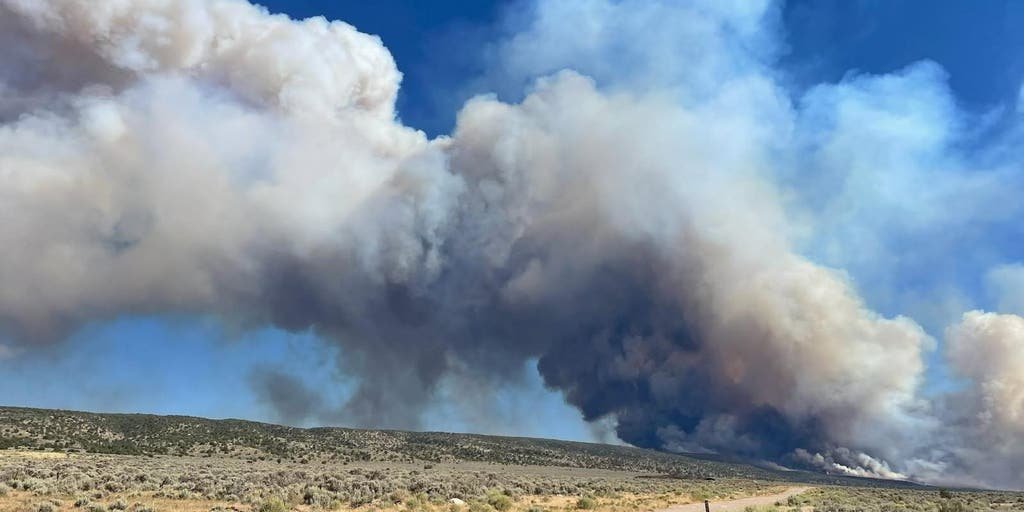Wildfires Rage at Grand Canyon: A Threat to Nature’s Majesty
As the sun dipped below the horizon, casting a warm orange hue across the expansive landscape, an ominous haze began to engulf the North Rim of the Grand Canyon. Just hours earlier, the serenity of this natural wonder was shattered by the roar of flames consuming dry brush and towering pines in what has been dubbed the White Sage Fire. With evacuation orders echoing through the air, the delicate balance of nature faced yet another test.
The White Sage Fire: A Growing Threat
Situated near the serene Jacob Lake and Fredonia, Arizona, the White Sage Fire ignited Wednesday night under conditions ripe for wildfires — low humidity and high winds. As of Friday morning, it had rapidly spread to approximately 1,000 acres, leading park authorities to implement immediate evacuation protocols to safeguard visitors and wildlife alike.
“This fire is a stark reminder of the fragile ecosystem at the Grand Canyon,” explains Dr. Linda Ramirez, a wildfire ecology expert from the University of Arizona. “Wildfires are a natural part of many ecosystems, but their frequency and intensity are increasing due to climate change.” With the National Park Service confirming that both the White Sage Fire and the ongoing Dragon Bravo Fire, which has consumed about 120 acres, were caused by lightning, the dual threats raised concerns among scientists and officials alike.
Challenges on the Ground
The rapid spread of the White Sage Fire posed logistical challenges for both firefighters and visitors. Road closures, particularly along State Route 89A to Fredonia, complicated evacuation routes, as park officials worked diligently to ensure the safety of all individuals present. Their proactive responses were vital, considering that similar events in national parks have seen disastrous consequences in the past.
- Evacuation Orders: All visitors were asked to leave the North Rim area immediately.
- Road Closures: Key routes were shut down to facilitate safe evacuations.
- Immediate Response: Firefighters were deployed swiftly to combat the flames.
“The situation requires a balance of protecting human life while also prioritizing the ecology,” states Mark Thompson, a fire management specialist. “If conditions worsen, we may see even larger fires impacting species that are already endangered. The complexities of managing fire in such a biodiverse area cannot be overstated.”
The Broader Implications of Wildfires
The frequency of wildfires in the United States, particularly in the West, has escalated alarmingly in recent years. According to a study published in *Ecological Applications*, wildfire incidents have increased by nearly 25% over the last decade, exacerbated by hotter conditions attributed to climate change. Dr. Ramirez elaborates, “As we continue to alter our climate, we are observing patterns that create perfect storms for these blazes.”
While wildfires do play a critical role in certain ecosystems—helping to clear away underbrush and promote new growth—they often come at a staggering cost. “The ecological benefits are often overshadowed by the immediate dangers they pose to human life, habitat destruction, and air quality,” she notes. Wildfires release vast amounts of carbon dioxide into the atmosphere, impacting climate change further. The balance, therefore, becomes precarious.
Historic Fires and Future Projections
Historic wildfires have reshaped landscapes, but contemporary fires pose new challenges. Variables including human encroachment, altered land management practices, and climate change contribute to increasingly severe fire seasons. National parks, which usually function as sanctuaries for biodiversity, are now facing existential threats.
Statistics show that since 2000, wildfires in the U.S. have burned over 50 million acres of land, according to the National Interagency Fire Center. Many experts worry about the long-term ramifications. Dr. Nathan Gold, a conservation biologist, voices a crucial point: “Protecting natural habitats through better land use and fire management practices is vital if we wish to mitigate these risks. Our reliance on traditional firefighting methods may not be sustainable.”
A Call to Action
The need for proactive measures to combat both climate change and wildfires is becoming increasingly urgent. Scientists are advocating for adaptive land management strategies, including controlled burns and the removal of excess underbrush to reduce fire intensity. Moreover, collaboration between governmental agencies, environmental organizations, and local communities is essential.
“The threat of wildfires will only grow unless we take tangible actions to reform how we engage with our landscapes,” Dr. Ramirez urges. “This is not merely a regional issue but a global crisis.”
As firefighters continue to battle the White Sage Fire, the Grand Canyon remains a poignant symbol of nature’s resilience and vulnerability. Each flicker of flame and plume of smoke is a stark reminder that while the majesty of the Grand Canyon may be eternal, its preservation is a responsibility we all share. The challenge lies not just in fighting the fires of today but in cultivating a sustainable future for the wild landscapes of tomorrow.









